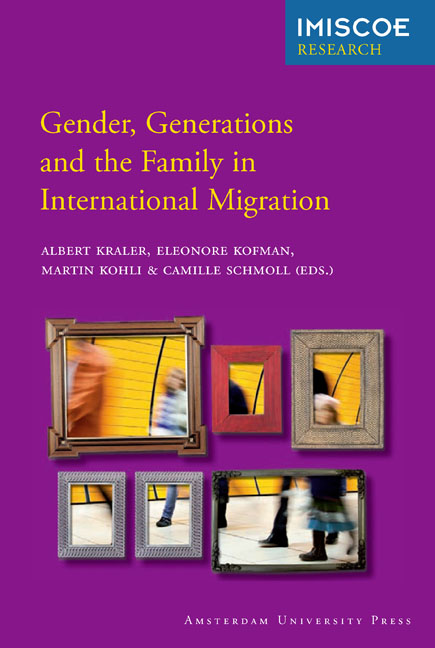Book contents
- Frontmatter
- Contents
- Preface
- 1 Introduction: Issues and Debates on Family-Related Migration and the Migrant Family: A European Perspective
- Section I The Family as a Moral and Social Order
- Section II Gender, Generation and Work in the Migrant Family
- Section III Marriage Migration and Gender Relations
- Section IV Transnational Family Lives and Practices
- List of Contributors
- Index
- Other IMISCOE titles
11 - ‘He’s the Swiss Citizen, I’m the Foreign Spouse’: Binational Marriages and the Impact of Family-Related Migration Policies on Gender Relations
Published online by Cambridge University Press: 21 January 2021
- Frontmatter
- Contents
- Preface
- 1 Introduction: Issues and Debates on Family-Related Migration and the Migrant Family: A European Perspective
- Section I The Family as a Moral and Social Order
- Section II Gender, Generation and Work in the Migrant Family
- Section III Marriage Migration and Gender Relations
- Section IV Transnational Family Lives and Practices
- List of Contributors
- Index
- Other IMISCOE titles
Summary
Introduction
In Switzerland, like other European countries, family-related migration remains the main means of immigration. Nearly 40 per cent of the immigrants who entered Switzerland between 1998 and 2007 did so for reasons of marriage or family reunification, while only a quarter entered because of employment (SFS 2008). One of the reasons the ratio of family-related immigration to labour immigration is so high is that the Swiss government has traditionally limited the number of employment immigrants, whereas family immigration has not been so tightly controlled.
As in other European countries (Grillo 2008; Kofman, Kraler, Kohli & Schmoll and Grillo this volume), public debates within Switzerland over migrant families and marriage migration have intensified in recent years and become a major issue in policymaking. In these debates, the ‘migrant family’ is often represented as an obstacle to integration, characterised by patriarchal relationships and illiberal practices. The idea that the values and practices of migrant families are embedded in gender inequalities and thus are at odds with values embodied by the supposed ‘Swiss family’ is prevalent in these debates.
In this ongoing controversy, ‘migrant families’ are often imagined to solely comprise individuals of the same ethnic origin and citizenship. In the Swiss case, this assumption no longer holds. Nearly a third of the immigrants who enter the country for reasons of marriage or family reunification do so to join a Swiss citizen (SFS 2008). Indeed, since the 1990s, binational marriages, involving women and men of diverse national and ethnic backgrounds, have become a main form of family-related migration: in 2007, 37 per cent of all marriages in Switzerland were between a Swiss citizen and a foreigner. Over two thirds of these marriages were between a Swiss man and a foreign woman (SFS 2008). The majority of these female foreign spouses are Europeans (60 per cent), followed by Asians (15.4 per cent) and Latin Americans (15 per cent) (SFS 2008). Marrying a Swiss man has become a principal mechanism for the migration of women to Switzerland, particularly for those from countries not formally part of the European Union (‘third-country states’). An expression of this trend is the dramatic increase in the numbers of migrant women in recent years: whereas in 1980 only 48 per cent of all Latin American immigrants were women, by the year 2008 the portion had increased to 64 per cent.
- Type
- Chapter
- Information
- Gender, Generations and the Family in International Migration , pp. 265 - 284Publisher: Amsterdam University PressPrint publication year: 2012
- 6
- Cited by



